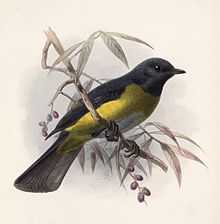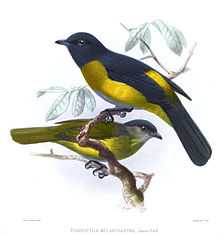Black-and-yellow Phainoptila
| Black-and-yellow Phainoptila | |
|---|---|
 | |
| Conservation status | |
| Scientific classification | |
| Kingdom: | Animalia |
| Phylum: | Chordata |
| Class: | Aves |
| Order: | Passeriformes |
| Family: | Ptiliogonatidae |
| Genus: | Phainoptila Salvin, 1877 |
| Species: | P. melanoxantha |
| Binomial name | |
| Phainoptila melanoxantha Salvin, 1877 | |
The Black-and-yellow Phainoptila or Black-and-yellow Silky-flycatcher (Phainoptila melanoxantha) is a species of bird in the Ptilogonatidae family. It is monotypic within the genus Phainoptila.[2] It is found in Costa Rica and Panama.
Description

The Black-and-yellow Phainoptila is a small, rotund bird with distinctive yellow flanks. Males have a black back, head and tail, yellow flanks and rump, olive breasts and grey bellies. Females have a black cap, olive breast, rump, wings and tail, yellow flanks, and grey throat, nape, and belly. Young are similar to adult female, but duller and with no grey on nape and dusky streaking on breast.
Habitat and range
Black-and-yellow Phainoptilas are found from Costa Rica to western Panama, in mountains from 1800 m (6000 ft.) to timberline, although they may wander lower after breeding season. Found in highland forests and adjacent second growth and gardens.
Habits and voice
Black-and-yellow Phainoptilas frequent middle levels and upper understory of highland forests. Eats mainly of berries of trees, epiphytes, and shrubs. Rather sluggish and sedentary, often spends long periods of time stuffing itself with berries from a single tree. Occasionally accompanies Sooty-capped Bush-Tanager flocks, but soon lags behind. Occasionally plucks insects foliage or catches them in the air, though not often. Usually found alone or pairs, forms loose flocks after breeding season.
Call is a high, sharp, thin tsit or tseep, suggesting a much smaller bird. Appears to not sing.
Nesting
Nest is a compact, bulky, cup of green moss, thin stems and fern fronds. Found 5–13 ft. (1.5–4 m) up in a dense shrup or sapling. Lays 2 spotted, greyish-white eggs. Nesting occurs from April to May.
References
- ↑ BirdLife International (2012). "Phainoptila melanoxantha". IUCN Red List of Threatened Species. Version 2013.2. International Union for Conservation of Nature. Retrieved 26 November 2013.
- ↑ "ITIS Report: Phainoptila". Integrated Taxonomic Information System. Retrieved 14 March 2013.
